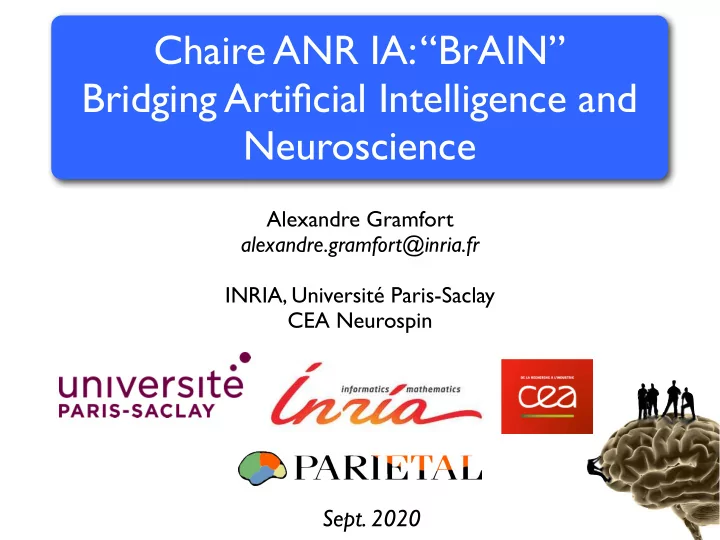

Chaire ANR IA: “BrAIN” Bridging Artificial Intelligence and Neuroscience Alexandre Gramfort alexandre.gramfort@inria.fr INRIA, Université Paris-Saclay CEA Neurospin Sept. 2020
Supervised learning with fMRI y X Image, sound, task Scanning m i t s �������� Decoding ����������������� ������������� �������� � ����������� �������������� fMRI volume ����������������� Any variable: �������� ���������� healthy? Objective: Predict y given X or learn a function f : X → y 2 Alexandre Gramfort Chaire IA BrAIN
Precision medicine / Biomarkers https://paris-saclay-cds.github.io/autism_challenge/
Why more data is better? • 5 subjects • 12 sessions (more than 1000 scans) • Binary classification (face vs. house) • Test of 2 left-out sessions Data from [Haxby et al. 2001] Figure from [Gramfort et al. 2011] 4 Alexandre Gramfort Chaire IA BrAIN
Why more data is better? • 5 subjects • 12 sessions (more than 1000 scans) • Binary classification (face vs. house) • Test of 2 left-out sessions The more data the better Data from [Haxby et al. 2001] Figure from [Gramfort et al. 2011] 4 Alexandre Gramfort Chaire IA BrAIN
Why more data is better? • 5 subjects • 12 sessions (more than 1000 scans) • Binary classification (face vs. house) • Test of 2 left-out sessions The more data the better Almost 100% (no noise) Data from [Haxby et al. 2001] Figure from [Gramfort et al. 2011] 4 Alexandre Gramfort Chaire IA BrAIN
Problem: “big data” in science is generally unsupervised
Project 1 • Objective: Learning representations from neural time series with self-supervision and data augmentation
Project 1 • Objective: Learning representations from neural time series with self-supervision and data augmentation Self-supervision to the rescue Original image Input patches Output E.g.: Jigsaw puzzle task from Noroozi & Favaro (2016) In a nutshell: use the structure of the data to pretrain a feature extractor with a supervised (“pretext”) task – then use the features. Other examples : word2vec, BERT, nonlinear ICA, etc.
Project 1 • Objective: Learning representations from neural time series with self-supervision and data augmentation SSL to learn on sleep EEG [Banville et al. MLSP 2019]
Problem: What pretext task makes sense for EEG/ MEG? • Use knowledge about sleep (slow cycles) • Theoretical approaches based on recent results on identifiability of non-linear ICA
Possible Self Sup. Tasks 1 Sampling 2 Training Amplitude (e.g., � V) positioning (RP) Logistic ch1 Relative regression ch2 ch3 ch4 Time (e.g., minutes, hours) Predict if 2 windows of data are close in time Other approaches: CPC [Oord et al. 2018], PCL [Hyvärinen et al. 2017] etc. � 9 Alexandre Gramfort Chaire IA BrAIN
Project 1 • Objective: Learning representations from neural time series with self-supervision and data augmentation 10 Alexandre Gramfort Chaire IA BrAIN
Problem: Augmenting MEG/EEG data is not as simple as for images or speech • Use the physics of MEG/EEG • Use knowledge/availability of pure noise • Use knowledge about neuroscience (freq. shifts, biophysiological models)
Problem: Augmenting MEG/EEG data is not as simple as for images or speech • Use the physics of MEG/EEG • Use knowledge/availability of pure noise • Use knowledge about neuroscience (freq. We want to learn how to augment neuroscience data! shifts, biophysiological models)
Problem of dataset variability • ≠ recording devices / scanners • ≠ EEG channels / fMRI sequence parameters • ≠ preprocessing steps • ≠ populations: ages, sexes, clinical disorders… • ≠ labeling guidelines 12 Alexandre Gramfort Chaire IA BrAIN
Problem of dataset variability • ≠ recording devices / scanners • ≠ EEG channels / fMRI sequence parameters • ≠ preprocessing steps • ≠ populations: ages, sexes, clinical disorders… • ≠ labeling guidelines • Pooling datasets to increase n can reduce performance • Performance on new dataset can drop 12 Alexandre Gramfort Chaire IA BrAIN
Problem of dataset variability • ≠ recording devices / scanners • ≠ EEG channels / fMRI sequence parameters • ≠ preprocessing steps • ≠ populations: ages, sexes, clinical disorders… • ≠ labeling guidelines • Pooling datasets to increase n can reduce performance • Performance on new dataset can drop [Torralba and Efros, 2011] 12 Alexandre Gramfort Chaire IA BrAIN
Domain adaptation with EEG sleep • Train dataset: MESA [Dean et al. 2016] • Test dataset: MASS-session 3 [O’Reilly et al. 2014] • 3 EEG + 2 EOG channels [Chambon et al., Domain adaptation with optimal transport improves EEG sleep stage classifiers, PRNI 2018] 13 Alexandre Gramfort Chaire IA BrAIN
Domain adaptation with EEG sleep • Train dataset: MESA [Dean et al. 2016] • Test dataset: MASS-session 3 [O’Reilly et al. 2014] • 3 EEG + 2 EOG channels Domain adaptation improves performance [Chambon et al., Domain adaptation with optimal transport improves EEG sleep stage classifiers, PRNI 2018] 13 Alexandre Gramfort Chaire IA BrAIN
How do we impact neuroscience and medicine?
Predict of brain “fragility” for optimal drug dosage across age Joint work with:
https://mne.tools/ Transfer + impact with MNE MNE software for processing MEG and EEG data , A. Gramfort, M. Luessi, E. Larson, D. Engemann, D. Strohmeier, C. Brodbeck, L. Parkkonen, M. Hämäläinen, Neuroimage 2013
Objectives BrAIN objective: Develop the next ML paradigms to extract knowledge from physiological signals O1. Learn with no-supervision on noisy and complex multivariate signals O2. Learn end-to-end predictive systems from limited data exploiting physical constraints O3. Learn from data coming from many different source domains O4. Develop high-quality software tools that can reach clinical research 17 Alexandre Gramfort Chaire IA BrAIN
Team • Denis Engemann • Thomas Moreau • 1 Post-doc • 1 Engineer • 3 PhDs • INSERM team at Larib. for clinical cases • Aapo Hyvärinen as external collaborator/visitor 18 Alexandre Gramfort Chaire IA BrAIN
Contact http://alexandre.gramfort.net GitHub : @agramfort Twitter : @agramfort "An approximate answer to the right problem is worth a good deal more than an exact answer to an approximate problem. ~ John Tukey"
Recommend
More recommend